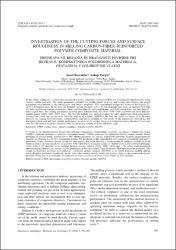Investigation of the cutting forces and surface roughness in milling carbon fiber reinforced polymer composite material
Citation
Bayraktar, S., Turgut, Y. (2016). Investigation of the cutting forces and surface roughness in milling carbon fiber reinforced polymer composite material. Materiali in Tehnologije, 50(4), 591-600. https://doi.org/10.17222/mit.2015.199Abstract
In this study, milling of a carbon-fiber-reinforced polymer composite material (CFRP) was investigated experimentally using various carbide end mills. the input parameters included the spindle speed, feed rate and cutting tool, whereas the output parameters were defined as the cutting force and surface roughness. the experimental design was based on the Taguchi L-18 (6(1)x3(2)) orthogonal array. in the tests, six different carbide end mills with a 10 mm diameter were used: an uncoated two-flute 30 helix-angled one; carbide-coated two-, three- and four-flute 30 helix-angled ones; and TiAl-coated three- and four-flute 45 helix-angled ones. the cutting parameters included three different feed rates (0.03, 0.06, 0.09) mm/tooth and three different spindle speeds (3800, 4800, 5800) min(-1). the Taguchi method was applied to select the most appropriate cutting parameters (cutting force, feed rate) for the tests. With the analysis of variance (ANOVA), the feed-rate factor was found to be the most effective one among these parameters (cutting forces and surface roughness). the results of the experiments showed that the uncoated carbide end mill had a better performance in terms of the cutting forces and surface roughness. Besides, it was also seen that the surface roughness increases with the increasing number of flutes and helix angle.


















